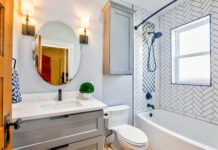Are you still afraid to use rich colors in your interior? Then we go to you. Color in interior design is a working tool, a means of expressing emotion, highlighting accents, highlighting pluses, and hiding flaws.
Go outside and look around, look in the mirror – everything around is colorful. Depending on the season, the colors change become paler or more intense, but the stain always remains. Even the endless snowy expanse during the day changes its color depending on the lighting – from pale gold in the morning to lilac and blue at dusk. Bathroom supply store New Bathroom Style knows how white has many shades, on the nuances of which it is realistic to build an interior.
Great architects at all times have used color as a tool to influence audiences. Baroque, classicism, art deco, avant-garde, and modernism – any architectural trend has its palette. “Color in architecture is as powerful as plan and cut. Or better: polychromy is itself a component of plan and cut,” wrote Le Corbusier.
Fighting stereotypes
Over the spaces of modern houses, bathrooms with modern bathroom vanities, we affirm with the same confidence: there will be color.Often people are afraid of color in the interior, but this is due to the inability to work with it and the misunderstanding that color accents allow you to create an unlimited number of interior scenarios.
The different color harmonies depend on the concept. A white interior should be emphasized with bright spots of decor (vases, paintings), textiles (curtains, pillows, furniture upholstery), add the juicy green color of indoor plants.
Who said that the classics are beige? Why are classic interiors today represented by a range of light brown shades? Remember the interiors of the Winter Palace – can you call them monochrome? Enfilade of rooms with emerald, tangerine, azure-blue walls, and against the background of all this diversity – furniture in multi-colored velvet upholstery.
Designers constantly have to deal with the fears of the interior customer. A girl’s room isn’t always pink, and a boy doesn’t have to live in shades of blue. There is a good trick for those who still doubt that it will be comfortable with bright colors in the interior- experimenting with combinations and color accents in textiles (pillows, window decoration, carpets). They will add color spots; besides, if desired, the coloristic scenario of the interior is easy to change.
Picture gallery for inspiration
We are happy to paint the walls in different colors. Large chromatic planes visually expand the space, increase the height, and hide flaws. There is a mass of literature on color for those who are not confident in their ability to choose harmonious combinations.
It’s easy to get inspired: go to an art gallery. Learn from the masters, no matter who is closer to you: impressionists, Suprematists, or representatives of hyperrealism. Look around – color is everywhere.
Semantic center
Colored furniture can become the semantic center of an apartment and bathroom, your unique bathroom vanities.In this project (see photo at the beginning of the article), the focus is on a caramel-colored cubic furniture structure. All other surface elements are neutral. Small color accents are placed in the wall decor (paintings, posters).


























